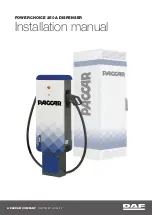
Jump Starting
If the battery is discharged the engine
can be started with jumper cables and
the (12 V) battery of another vehicle.
Proceed as follows:
1. Position the vehicle with the charged
battery so that the jumper cables will
reach, but never let the vehicles
touch. Make sure the jumper cables
do not have loose or missinq insula
tion.
2. On both vehicles:
• Turn off engine and all lights and
accessories, except hazard
flashers or work lights.
• Apply parking brake and shift
selector lever to position “ P”
(neutral for manual transmis
sion).
• Be sure the vent caps are tight
and level. Place a damp cloth
over the vent caps, making cer
tain it is clear of all moving parts.
3. Clamp one end of the first jumper
cable to the positive (+) terminal on
the discharged battery and the other
end to the positive (+ ) terminal on
the charged battery. Make sure the
cable clamps do not touch any other
metal parts.
4. Clamp one end of the second jumper
cable to the grounded negative ( - )
terminal of the charged battery and
the final connection to a grounded
heavy metal bracket in the engine
compartment or on the engine of the
disabled vehicle. Make sure the
cables are not on or near pulleys,
fans, or other parts that will move
when the engine is started.
5. Start engine of the vehicle with the
charged battery and run at high idle.
Then start engine of the disabled
vehicle in the usual manner.
6. After the engine has started, remove
jumper cables by reversing the
above installation sequence exactly,
starting with the jumper cable con
nected to a heavy metal bracket in
the disabled vehicle’s engine com
partment. When removing each
clamp, make sure that it does not
touch any other metal while the
other end is still attached.
Important!
A discharged battery can freeze at
approx. - 1 0 ° C (+14° F). In all cases it
must be thawed out before jumper
cables are used.
Jumper cable specifications:
• Minimum cable cross-section of
25 mm2 or approx. 2 AWG
• Maximum length of 3500 mm
(11.5 ft).
Warning!
Never lean over batteries while jump
starting, you might get burned.
Battery fluid contains sulfuric acid.
Do not allow this fluid to come in
contact with eyes, skin, or clothing.
In case it does, immediately flush
affected area with water, and seek
medical help.
A battery will also produce hydro
gen gas, which is flammable and
explosive. Keep flames or sparks
away from battery, i.e. improper
connection of jumper cables, smok
ing, etc..
Summary of Contents for 190 E 2.3-16 201 1987
Page 1: ......
Page 3: ...Owner s Manual 190E2 3 16 Model 201 1987...
Page 13: ...I 11 I n s t r u m o r v...
Page 15: ...I 13...
Page 22: ......
Page 56: ......
Page 68: ......
Page 92: ......
Page 103: ...Index 101 I...
Page 108: ......
Page 109: ......
Page 113: ......
















































